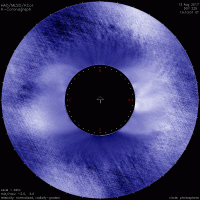With a quiet Sun, no active sunspot regions on the face or limb of the visible disk, one wonders what the solar corona will look like. What will we see when the Moon blots out the Sun and the corona is revealed.

Just up the hill from me is the Mauna Loa Solar Observatory. I know a couple folks that work there and have toured the facility. MLSO is a fairly modest telescope equipped with some very specialized instruments. This telescope stares at the Sun all day, every day, monitoring our star as part of a worldwide network of solar observatories.
For this conversation it is the coronagraph images that are interesting. With only a few days to go before the eclipse I would suspect that these images give us a good idea of what to expect.

The dark disk in the center of the image shows where the coronagraph has blocked the direct sunlight. A dotted line indicates where the edge of the Sun would be in the image if it were visible.
You can also check out the SOHO spacecraft LASCO coronagraph. Unfortunately the LASCO occulting disk blocks more of the inner corona near the edge of the Sun.

It is unlikely that there will be major prominences visible, loops and jets of hot gas visible along the edge of the Sun.
What we will actually see? That will have to wait for eclipse day to be revealed. but we can get an idea of what to expect. While we can observe the corona with instruments, the view during the total solar eclipse will be substantially better, and far more beautiful.

